Articles científics destacats
Aquesta secció inclou una llista dels treballs científics més destacats de l'IMB-CNM publicats en revistes incloses al Science Citation Index (SCI), per any de publicació.
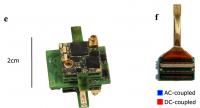
Graphene active sensors have demonstrated promising capabilities for the detection of electrophysiological signals in the brain. Their functional properties, together with their flexibility as well as their expected stability and biocompatibility have raised them as a promising building block for large-scale sensing neural interfaces. However, in order to provide reliable tools for neuroscience and biomedical engineering applications, the maturity of this technology must be thoroughly studied. Here, we evaluate the performance of 64-channel graphene sensor arrays in terms of homogeneity, sensitivity and stability using a wireless, quasi-commercial headstage and demonstrate the biocompatibility of epicortical graphene chronic implants. Furthermore, to illustrate the potential of the technology to detect cortical signals from infra-slow to high-gamma frequency bands, we perform proof-of-concept long-term wireless recording in a freely behaving rodent. Our work demonstrates the maturity of the graphene-based technology, which represents a promising candidate for chronic, wide frequency band neural sensing interfaces.
Nature Communications, (2021), 12, 1, (211), 10.1038/s41467-020-20546-w

The large electrocaloric coupling in PbZrO3 allows using high-speed infrared imaging for visualizing anti-ferroelectric switching dynamics via the associated temperature change. It is found that in ceramic samples of homogeneous temperature and thickness, switching is fast due to the generation of multiple nucleation sites, with devices responding in the millisecond range. By introducing gradients of thickness, however, it is possible to change the dynamics to propagation limited, whereby a single-phase boundary sweeps across the sample like a cold front, at a speed of ≈20 cm s−1. Additionally, introducing thermostatic temperature differences between two sides of the sample enables the simultaneous generation of a negative electrocaloric effect on one side and a positive one on the other, yielding a Janus-like electrocaloric response.
Advanced Electronic Materials, 2021, 2100380, DOI: 10.1002/aelm.202100380
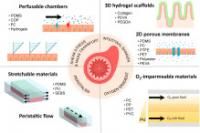
Over the last few years, the intestine has been extensively studied using in vitro microfluidic systems, commonly known as gut-on-a-chip (GOC) devices. This interest has been due not only to the importance of the intestine's proper functions but also to the relationship that this organ and the microbiota that inhabits it has with the rest of the body's organs. The increased complexity of these in vitro systems, together with the need to improve our understanding of intestinal physiology interdependencies, has led to greater focus on the integration of biosensors within these devices. However, the current number of GOC devices with integrated sensors for monitoring relevant physiological parameters are very limited and demand the use of external analytical techniques that delay the analysis and prevent real-time decision-making. This paper reviews the various materials, technologies, and structures that have been used both for mimicking the physiology of the intestine and monitoring relevant physiological parameters, such as permeability of the gut barrier, dissolved oxygen concentration, cytokines profile and the production of microbial short-chain fatty acids. We also propose alternative biosensing techniques demonstrated in other in vitro and lab-on-a-chip devices that could be translated to GOC models. A critical analysis of the requirements, limitations, and current challenges on the microenvironment replication and monitorization of GOC models is included, with a particular focus on the physiological parameters and biomarkers that should be detected simultaneously in real-time to get a proper framework of the gut function that until now, have not received the necessary attention.
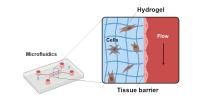
Tissue barriers play a crucial role in human physiology by establishing tissue compartmentalization and regulating organ homeostasis. Combining hydrogels with microfluidics technology provides unique opportunities to better recreate in vitro the tissue barrier models including the cellular components and the functionality of the in vivo tissues. Such platforms have the potential of greatly improving the predictive capacities of the in vitro systems in applications such as drug development, or disease modeling. Nevertheless, their development is not without challenges in their microfabrication. In this review, we will discuss the recent advances driving the fabrication of hydrogel microfluidic platforms and their applications in multiple tissue barrier models.
ACS Appl. Mater. Interfaces 2021, 13, 12, 13920–13933. https://doi.org/10.1021/acsami.0c21573
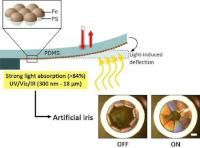
Ultrabroadband light absorbers are attracting increasing interest for applications in energy harvesting, photodetection, self-regulated devices or soft robotics. The developed metamaterial, composed of a nanostructured Fe layer mechanically coupled to a thin polydimethylsiloxane (PDMS) film, shows unprecedented ultrabroadband and angle-independent optical absorption (averaging 84% within 300–18000 nm). The excellent photothermal efficiency and large thermal-expansion mismatch of the metamaterial is efficiently transformed into large mechanical deflections, which we exploit to show an artificial iris that self-regulates the transmitted light power from the ultraviolet to the long-wave infrared, an untethered light-controlled mechanical gripper and a light-triggered electrical switch.
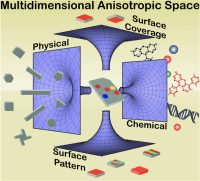
Next generation technologies will require Multidimensional Anisotropic Architectures with tunable physical and chemical intraparticle building blocks combination to meet the demands of high throughput and multiplexing. Here, we report a strategy to integrate a vast number of anisotropic dimensions combining polymer photolithography with (bio)chemical modifications via soft lithography. Our work allows a combination of microparticle traits in a 15-dimensional anisotropic space at the micrometric scale. No current technology provides these degrees of physical, chemical, surface coverage, and surface pattern anisotropies, which can be used interchangeably or in combination; obtaining an innumerable number of engineering microparticles with barcoding capabilities.
Small 2020, 2004691, doi: 10.1002/smll.202004691
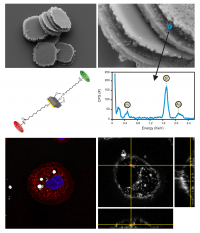
Taking advantage of the ability of microelectronics to manufacture devices under cell dimensions and a large variety of features, we report a technology for the fabrication of multi-material chips as bi-functional cell-internalizable devices. These microtools have a promising future as intracellular functional platforms for biosensing, diagnosis and drug delivery.
Sensors and Actuators B. Chemical, 209, 212-224 (2015)
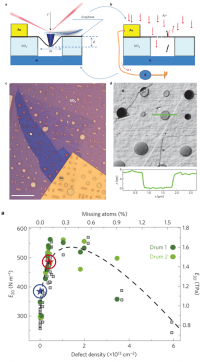
The presence of lattice defects in graphene might degrade its mechanical properties. We report a study on the elastic modulus and strength with a controlled density of defects. Counter-intuitively, the in-plane Young’s modulus increases with defect density up to 2x the initial value for a vacancy content of ~0.2%.
Nature Physics 11, 26–31 (2015)
The adhesion of small silicon chips to cells has many potential applications as direct interconnection of the cells to the external world can be accomplished. Although some typical applications of silicon nanowires integrated into microsystems are focused on achieving a cell-on-a-chip strategy, we are interested in obtaining chip-on-a-cell systems. This paper reports the design, technological development and characterization of polysilicon barcodes featuring silicon nanowires as nanoscale attachment to identify and track living mouse embryos during their in vitro development.
Lab on a Chip, 15, 1508-1514 (2015)
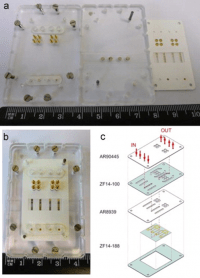
We report on the production of a low cost microfluidic device for the multiplexed electrochemical detection of magneto bioassays. As a proof of concept, the device has been used to detect Myeloperoxidase (MPO), a cardiovascular biomarker. A dual MPO mass and activity assay has been finally applied to the study of 10 real plasma samples, allowing patient classification according to the risk of suffering a cardiovascular event.
Biosensors and Bioelectronics 69, 328–336 (2015)




